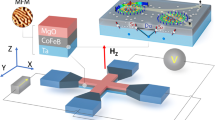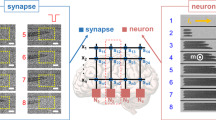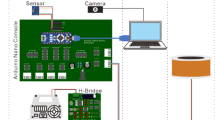Abstract
Integrating magnetic skyrmions into neuromorphic computing could help improve hardware efficiency and computational power. However, developing a scalable implementation of the weighted sum of neuron signals—a core operation in neural networks—has remained a challenge. Here we show that weighted sum operations can be performed in a compact, biologically inspired manner by using the non-volatile and particle-like characteristics of magnetic skyrmions that make them easily countable and summable. The skyrmions are electrically generated in numbers proportional to an input with an efficiency given by a non-volatile weight. The chiral particles are then directed using localized current injections to a location in which their presence is quantified through non-perturbative electrical measurements. Our experimental demonstration, which currently has two inputs, can be scaled to accommodate multiple inputs and outputs using a crossbar-array design, potentially nearing the energy efficiency observed in biological systems.
This is a preview of subscription content, access via your institution
Access options
Access Nature and 54 other Nature Portfolio journals
Get Nature+, our best-value online-access subscription
$32.99 / 30 days
cancel any time
Subscribe to this journal
Receive 12 digital issues and online access to articles
$119.00 per year
only $9.92 per issue
Buy this article
- Purchase on SpringerLink
- Instant access to full article PDF
Prices may be subject to local taxes which are calculated during checkout





Similar content being viewed by others
Data availability
The data that support the findings of this study are available via Zenodo at https://doi.org/10.5281/zenodo.13988409 (ref. 60). Other relevant data are available from the corresponding authors on request.
References
Fert, A., Reyren, N. & Cros, V. Magnetic skyrmions: advances in physics and potential applications. Nat. Rev. Mater. 2, 17031 (2017).
Moreau-Luchaire, C. et al. Additive interfacial chiral interaction in multilayers for stabilization of small individual skyrmions at room temperature. Nat. Nanotechnol. 11, 444–448 (2016).
Jiang, W. et al. Blowing magnetic skyrmion bubbles. Science 349, 283–286 (2015).
Woo, S. et al. Observation of room-temperature magnetic skyrmions and their current-driven dynamics in ultrathin metallic ferromagnets. Nat. Mater. 15, 501–506 (2016).
Boulle, O. et al. Room-temperature chiral magnetic skyrmions in ultrathin magnetic nanostructures. Nat. Nanotechnol. 11, 449–454 (2016).
Legrand, W. et al. Room-temperature current-induced generation and motion of sub-100 nm skyrmions. Nano Lett. 17, 2703–2712 (2017).
Büttner, F. et al. Field-free deterministic ultrafast creation of magnetic skyrmions by spin–orbit torques. Nat. Nanotechnol. 12, 1040–1044 (2017).
Soumyanarayanan, A. et al. Tunable room-temperature magnetic skyrmions in Ir/Fe/Co/Pt multilayers. Nat. Mater. 16, 898–904 (2017).
Finizio, S. et al. Deterministic field-free skyrmion nucleation at a nanoengineered injector device. Nano Lett. 19, 7246–7255 (2019).
Wang, Z. et al. Thermal generation, manipulation and thermoelectric detection of skyrmions. Nat. Electron. 3, 672–679 (2020).
Woo, S. et al. Deterministic creation and deletion of a single magnetic skyrmion observed by direct time-resolved X-ray microscopy. Nat. Electron. 1, 288–296 (2018).
Yang, S. et al. Electrical generation and deletion of magnetic skyrmion-bubbles via vertical current injection. Adv. Mater. 33, 2104406 (2021).
Maccariello, D. et al. Electrical detection of single magnetic skyrmions in metallic multilayers at room temperature. Nat. Nanotechnol. 13, 233–237 (2018).
Zeissler, K. et al. Discrete Hall resistivity contribution from Néel skyrmions in multilayer nanodiscs. Nat. Nanotechnol. 13, 1161–1166 (2018).
Hanneken, C. et al. Electrical detection of magnetic skyrmions by tunnelling non-collinear magnetoresistance. Nat. Nanotechnol. 10, 1039–1042 (2015).
Chen, S. et al. All-electrical skyrmionic magnetic tunnel junction. Nature 627, 522–527 (2024).
Urrestarazu Larrañaga, J. et al. Electrical detection and nucleation of a magnetic skyrmion in a magnetic tunnel junction observed via operando magnetic microscopy. Nano Lett. 24, 3557–3565 (2024).
Bourianoff, G., Pinna, D., Sitte, M. & Everschor-Sitte, K. Potential implementation of reservoir computing models based on magnetic skyrmions. AIP Adv. 8, 055602 (2018).
Song, K. M. et al. Skyrmion-based artificial synapses for neuromorphic computing. Nat. Electron. 3, 148–155 (2020).
Grollier, J. et al. Neuromorphic spintronics. Nat. Electron. 3, 360–370 (2020).
Huang, Y., Kang, W., Zhang, X., Zhou, Y. & Zhao, W. Magnetic skyrmion-based synaptic devices. Nanotechnology 28, 08LT02 (2017).
Sharad, M., Augustine, C., Panagopoulos, G. & Roy, K. Spin-based neuron model with domain-wall magnets as synapse. IEEE Trans. Nanotechnol. 11, 843–853 (2012).
Chen, R. et al. Nanoscale room-temperature multilayer skyrmionic synapse for deep spiking neural networks. Phys. Rev. Appl. 14, 014096 (2020).
Pinna, D. et al. Skyrmion gas manipulation for probabilistic computing. Phys. Rev. Appl. 9, 064018 (2018).
Zázvorka, J. et al. Thermal skyrmion diffusion used in a reshuffler device. Nat. Nanotechnol. 14, 658–661 (2019).
Prychynenko, D. et al. Magnetic skyrmion as a nonlinear resistive element: a potential building block for reservoir computing. Phys. Rev. Appl. 9, 014034 (2018).
Raab, K. et al. Brownian reservoir computing realized using geometrically confined skyrmion dynamics. Nat. Commun. 13, 6982 (2022).
Yokouchi, T. et al. Pattern recognition with neuromorphic computing using magnetic field–induced dynamics of skyrmions. Sci. Adv. 8, eabq5652 (2023).
Sun, Y. et al. Experimental demonstration of a skyrmion-enhanced strain-mediated physical reservoir computing system. Nat. Commun. 14, 3434 (2023).
Frenkel, C., Lefebvre, M., Legat, J.-D. & Bol, D. A 0.086-mm2 12.7-pJ/SOP 64k-synapse 256-neuron online-learning digital spiking neuromorphic processor in 28-nm CMOS. IEEE Trans. Biomed. Circuits Syst. 13, 145–158 (2019).
Attwell, D. & Laughlin, S. B. An energy budget for signaling in the grey matter of the brain. J. Cerebr. Blood Flow Metab. 21, 1133–1145 (2001).
Harris, J. J., Jolivet, R. & Attwell, D. Synaptic energy use and supply. Neuron 75, 762–777 (2012).
Chanaday, N. L., Cousin, M. A., Milosevic, I., Watanabe, S. & Morgan, J. R. The synaptic vesicle cycle revisited: new insights into the modes and mechanisms. J. Neurosci. 39, 8209–8216 (2019).
Kent, N. et al. Creation and observation of hopfions in magnetic multilayer systems. Nat. Commun. 12, 1562 (2021).
Grelier, M. et al. Three-dimensional skyrmionic cocoons in magnetic multilayers. Nat. Commun. 13, 6843 (2022).
Krishnia, S. et al. Large interfacial Rashba interaction generating strong spin–orbit torques in atomically thin metallic heterostructures. Nano Lett. 23, 6785–6791 (2023).
Jiang, W. et al. Direct observation of the skyrmion Hall effect. Nat. Phys. 13, 162–169 (2017).
Fert, A., Cros, V. & Sampaio, J. Skyrmions on the track. Nat. Nanotechnol. 8, 152–156 (2013).
He, B. et al. All-electrical 9-bit skyrmion-based racetrack memory designed with laser irradiation. Nano Lett. 23, 9482–9490 (2023).
Figueiredo-Prestes, N. et al. Magnetization switching and deterministic nucleation in Co/Ni multilayered disks induced by spin-orbit torques. Appl. Phys. Lett. 119, 032410 (2021).
Ambrogio, S. et al. An analog-AI chip for energy-efficient speech recognition and transcription. Nature 620, 768–775 (2023).
Torrejon, J. et al. Neuromorphic computing with nanoscale spintronic oscillators. Nature 547, 428–431 (2017).
Azghadi, M. R. et al. Hardware implementation of deep network accelerators towards healthcare and biomedical applications. IEEE Trans. Biomed. Circuits Syst. 14, 1138–1159 (2020).
Krishnia, S. et al. Quantifying the large contribution from orbital Rashba-Edelstein effect to the effective damping-like torque on magnetization. APL Mater. 12, 051105 (2024).
Schott, M. et al. The skyrmion switch: turning magnetic skyrmion bubbles on and off with an electric field. Nano Lett. 17, 3006–3012 (2017).
Bhattacharya, D. et al. Creation and annihilation of non-volatile fixed magnetic skyrmions using voltage control of magnetic anisotropy. Nat. Electron. 3, 539–545 (2020).
Bernand-Mantel, A. et al. Electric-field control of domain wall nucleation and pinning in a metallic ferromagnet. Appl. Phys. Lett. 102, 122406 (2013).
Bauer, U. et al. Magneto-ionic control of interfacial magnetism. Nat. Mater. 14, 174–181 (2015).
Herrera Diez, L. et al. Nonvolatile ionic modification of the Dzyaloshinskii-Moriya interaction. Phys. Rev. Appl. 12, 034005 (2019).
Srivastava, T. et al. Large-voltage tuning of Dzyaloshinskii–Moriya interactions: a route toward dynamic control of skyrmion chirality. Nano Lett. 18, 4871–4877 (2018).
Fillion, C.-E. et al. Gate-controlled skyrmion and domain wall chirality. Nat. Commun. 13, 5257 (2022).
Dai, B. et al. Electric field manipulation of spin chirality and skyrmion dynamic. Sci. Adv. 9, eade6836 (2023).
Mishra, R., Kumar, D. & Yang, H. Oxygen-migration-based spintronic device emulating a biological synapse. Phys. Rev. Appl. 11, 054065 (2019).
da Câmara Santa Clara Gomes, T. et al. Control of the magnetic anisotropy in multirepeat Pt/Co/Al heterostructures using magnetoionic gating. Phys. Rev. Appl. 21, 024010 (2024).
Legrand, W. et al. Room-temperature stabilization of antiferromagnetic skyrmions in synthetic antiferromagnets. Nat. Mater. 19, 34–42 (2020).
Juge, R. et al. Current-driven skyrmion dynamics and drive-dependent skyrmion Hall effect in an ultrathin film. Phys. Rev. Appl. 12, 044007 (2019).
Litzius, K. et al. The role of temperature and drive current in skyrmion dynamics. Nat. Electron. 3, 30–36 (2020).
He, Z. & Fan, D. A tunable magnetic skyrmion neuron cluster for energy efficient artificial neural network. In Design, Automation & Test in Europe Conference & Exhibition (DATE) 2017 350–355 (IEEE, 2017).
Raymenants, E. et al. Nanoscale domain wall devices with magnetic tunnel junction read and write. Nat. Electron. 4, 392–398 (2021).
da Câmara Santa Clara Gomes, T. et al. Data for: Neuromorphic weighted sums with magnetic skyrmions. Zenodo https://doi.org/10.5281/zenodo.13988409 (2024).
Acknowledgements
This work is supported by the Horizon 2020 Framework Program of the European Commission under FET-Proactive Grant SKYTOP (no. 824123), by the European Research Council advanced grant GrenaDyn (reference no. 101020684), by the EU project SkyANN (reference no. 101135729) and from a France 2030 government grant managed by the French National Research Agency (grant no. ANR-22-EXSP-0002 PEPR SPIN CHIREX).
Author information
Authors and Affiliations
Contributions
M.-B.M., P.S., V.C., J.G. and N.R. conceived the project. N.R., D.S.-H., Y.S. and T.d.C.S.C.G. designed the measurement procedure. S.C., Y.S. and T.d.C.S.C.G. grew the multilayer films and Ta electrodes. T.d.C.S.C.G. patterned the samples, acquired the magneto-optic Kerr effect and transport data, treated and analysed the data with support from Y.S., D.S.-H., S.K., M.-B.M., P.S., V.C., J.G. and N.R. T.d.C.S.C.G., V.C., J.G. and N.R. prepared the manuscript. All authors discussed and commented on the manuscript.
Corresponding authors
Ethics declarations
Competing interests
The authors declare no competing interests.
Peer review
Peer review information
Nature Electronics thanks Jayasimha Atulasimha and the other, anonymous, reviewer(s) for their contribution to the peer review of this work.
Additional information
Publisher’s note Springer Nature remains neutral with regard to jurisdictional claims in published maps and institutional affiliations.
Supplementary information
Supplementary Information
Supplementary Notes 1–11, Figs. 1–13 and discussion.
Rights and permissions
Springer Nature or its licensor (e.g. a society or other partner) holds exclusive rights to this article under a publishing agreement with the author(s) or other rightsholder(s); author self-archiving of the accepted manuscript version of this article is solely governed by the terms of such publishing agreement and applicable law.
About this article
Cite this article
da Câmara Santa Clara Gomes, T., Sassi, Y., Sanz-Hernández, D. et al. Neuromorphic weighted sums with magnetic skyrmions. Nat Electron 8, 204–214 (2025). https://doi.org/10.1038/s41928-024-01303-z
Received:
Accepted:
Published:
Issue date:
DOI: https://doi.org/10.1038/s41928-024-01303-z



